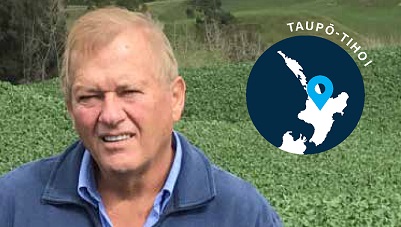Colin Armer runs system 1-2 dairy farms in the Taupō-Tihoi region, with no purchased feed. He has been dairy farming with his wife Dale in the area, for close to 30 years. He chats to Ballance National Corporate Account Manager, Aaron Stafford, about the grazing and pasture management strategies that he uses on farm.
Do you use any farm performance indicators to help you make on farm decisions?
“We have specific cover, and cow condition targets for the end of autumn, and we dry off accordingly to achieve those. We basically try and follow the grass curve really well and have our animals eat most of our spring pasture that might otherwise have to be harvested in some form or another.
We look for a strong clover base and we soil test every second year and monitor our soil tests over the long term. If we've got any nutrient shortfalls anywhere, we address them pretty much straight away. We think investing in soil fertility is the best thing that you can do.”
How have you seen your pastures change over time?
“I set up some trials to add additional clover seed by walking diagonally across some key paddocks to try and see if I needed to buy more clover. That proved to be a waste of time because I could never see the diagonal line. But when we buttoned back on the nitrogen and upped the potassium, the clover just came alive. I think the clover was lazy while we were feeding it too much nitrogen. The clover was there, but dormant. It wasn't a matter of needing to apply more clover seed. It was more about setting the clover up to succeed. We now have over 30% clover mix in our pastures.”
Dairy farmers are looking ahead to a tough season. What are your tips for riding out tight times?
“We just try to do a really good job of eating all the pasture that we’ve homegrown. We push our grazing rounds longer heading into Christmas, to try to push some of our spring surplus feed forward into a potentially dry summer.”
“We also use deferred grazing, which is a technique to cheaply shift feed from spring to summer. It doesn't look nice, but there's great benefits for the rest of the farm. If you've got surplus feed,you drop it out of the round, just like you would with silage, but you just don't cut it. And then, you go back to it at any time over the next two to three months and strip grazed it off like a crop, a standing feed source. If it's not grazed off until late January, February, then you're more than likely going to get seed drop, which has the effect of reseeding and strengthening the paddock. We always try to pick a weaker paddock with this in mind, so that the paddock can self-seed and regenerate.”
There's been a lot of talk about a shift from La Niña to El Niño. So more south-westerlies. That means different things all around the country. But is there anything that you consider or do differently with your farms?
“We are just going to keep doing better what we already do, we haven’t changed much other than that. We may have to consider drying some cows off earlier, in the autumn, than we otherwise would have.
Trying to capture what we can early and then see what evolves and adjust accordingly.”
What excites you about the future of farming in NZ?
“I think as a food producing nation whose costs are generally at the bottom end of the quartile, we have a wonderful outlook. When you compare our climate, soils and outdoor grazing systems based on clover-ryegrass based pastures, against the barn systems of our competitors, we have a superior product in grass fed milk and still have the advantage that we can provide competitively priced food. It’s as simple as that really.”
Contact your local Ballance Nutrient Specialist to chat about making the most of your nutrient spend.
Download the full PDF here
